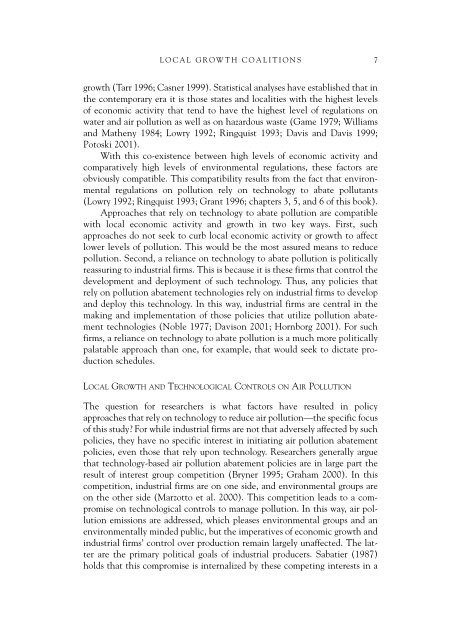GEORGE A. GONZALEZ - fieldi
GEORGE A. GONZALEZ - fieldi
GEORGE A. GONZALEZ - fieldi
Create successful ePaper yourself
Turn your PDF publications into a flip-book with our unique Google optimized e-Paper software.
LOCAL GROWTH COALITIONS 7growth (Tarr 1996; Casner 1999). Statistical analyses have established that inthe contemporary era it is those states and localities with the highest levelsof economic activity that tend to have the highest level of regulations onwater and air pollution as well as on hazardous waste (Game 1979; Williamsand Matheny 1984; Lowry 1992; Ringquist 1993; Davis and Davis 1999;Potoski 2001).With this co-existence between high levels of economic activity andcomparatively high levels of environmental regulations, these factors areobviously compatible. This compatibility results from the fact that environmentalregulations on pollution rely on technology to abate pollutants(Lowry 1992; Ringquist 1993; Grant 1996; chapters 3, 5, and 6 of this book).Approaches that rely on technology to abate pollution are compatiblewith local economic activity and growth in two key ways. First, suchapproaches do not seek to curb local economic activity or growth to affectlower levels of pollution. This would be the most assured means to reducepollution. Second, a reliance on technology to abate pollution is politicallyreassuring to industrial firms. This is because it is these firms that control thedevelopment and deployment of such technology. Thus, any policies thatrely on pollution abatement technologies rely on industrial firms to developand deploy this technology. In this way, industrial firms are central in themaking and implementation of those policies that utilize pollution abatementtechnologies (Noble 1977; Davison 2001; Hornborg 2001). For suchfirms, a reliance on technology to abate pollution is a much more politicallypalatable approach than one, for example, that would seek to dictate productionschedules.LOCAL GROWTH AND TECHNOLOGICAL CONTROLS ON AIR POLLUTIONThe question for researchers is what factors have resulted in policyapproaches that rely on technology to reduce air pollution—the specific focusof this study? For while industrial firms are not that adversely affected by suchpolicies, they have no specific interest in initiating air pollution abatementpolicies, even those that rely upon technology. Researchers generally arguethat technology-based air pollution abatement policies are in large part theresult of interest group competition (Bryner 1995; Graham 2000). In thiscompetition, industrial firms are on one side, and environmental groups areon the other side (Marzotto et al. 2000). This competition leads to a compromiseon technological controls to manage pollution. In this way, air pollutionemissions are addressed, which pleases environmental groups and anenvironmentally minded public, but the imperatives of economic growth andindustrial firms’ control over production remain largely unaffected. The latterare the primary political goals of industrial producers. Sabatier (1987)holds that this compromise is internalized by these competing interests in a









